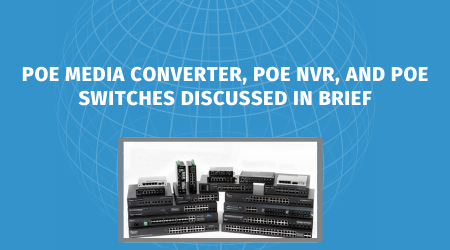
A Complete Guide to PoE Media Converter, NVR, and Switches

Power over Ethernet or PoE is a key technology for wired Ethernet networks, which is chosen over other traditional technologies owing to the simplicity and efficiency it assures. This technology enables carrying data and power signals over a single cable, thereby helping reduce the wiring and complex architecture associated with earlier technologies like wireless modems. The IEEE802.3af standard divides the PoE technology into two types – powered device (PD) and power sourcing equipment (PSE). The power sourcing equipment or PSE powers the connection, while PoE PD devices receive this power.
IP cameras, IP phones, and wireless access points are a few examples of PD, while PoE NVRs, PoE switches, and PoE media converters are a few important types of PSE devices used today. Generally, people focus on PoE PD devices. Owing to their widespread availability, it is easy to find information on them. However, PoE PSEs are rarely discussed. This post offers insights into PoE NVR, PoE switches, and PoE media converters and their applications in specific conditions.
General Introduction to PoE Media Converter, PoE NVR, and PoE Switch
The following pointers will help you in understanding the differences between PoE media converters, PoE NVRs, and PoE switches.
PoE Media Converters
Earlier media converters were only built to transmit only data. However, PoE media converters differ – they transmit data as well as power the connected devices over the network cable. Today, you can find several advanced PoE media converters that help optimize the value of hybrid networks involving fiber links. Nowadays, PoE media converters are used with fiber links to extend the distance and performance of remote PDs.
PoE NVRs
PoE NVR stands for power over Ethernet network video recorder, which features a built-in PoE switch. They are commonly used in the IP video surveillance systems, where they process the visual data received by the IP cameras by encoding it and then supply it for viewing or even record it for storage. Like a PoE media converter, PoE NVR is also known to power IP cameras through Ethernet cables. They help simplify the network architecture of PoE-based surveillance systems.
PoE Switches
As the name suggests, the PoE switch is the switch that features a built-in PoE injection. Like PoE NVR and PoE media converters, it can easily transmit power and data over the Ethernet cable to the device connected to it.
Applications of PoE Media Converters, PoE NVRs, and PoE Switches
Although the functions of these devices may seem similar, their properties largely differ across applications. The following pointers will help you understand them better.
- PoE NVR is designed to act as a switch as well as a recorder in the IP camera system. Having said that, does it mean separate PoE switches may not be needed in applications involving PoE NVR? Well, PoE NVRs available in the market may not possess advanced features like SNMP, PoE control and monitoring, and so on. Thus, PoE NVR is suited for small networks such as start-up businesses and homes.
- PoE switches are suited for Ethernet connections up to 100m. These devices feature LAN ports, especially copper Ethernet ports. There may be some fiber link SFP ports, too. The copper ports are usually ideal for 100 m connections, whereas the SFP uplinks can be connected to servers or switches that may be placed farther than 100 m. On contrary to this, PoE media converters on a whole help extend the connection extend beyond 100m. However, the only drawback is some PoE media converters lack networking features, which is why they are often combined with non-PoE switches in a network.
Conclusion
The demand for Power over Ethernet (PoE) technologies is expected to increase in the future. It is important to choose the right device for your network. However, that is not enough. To take advantage of PoE NVRS and PoE media converters, it is important to source them from trusted manufacturers or suppliers. While purchasing them, ensure to check all the specifications and compare them with your requirements. Most experienced manufacturers will help you understand them better.